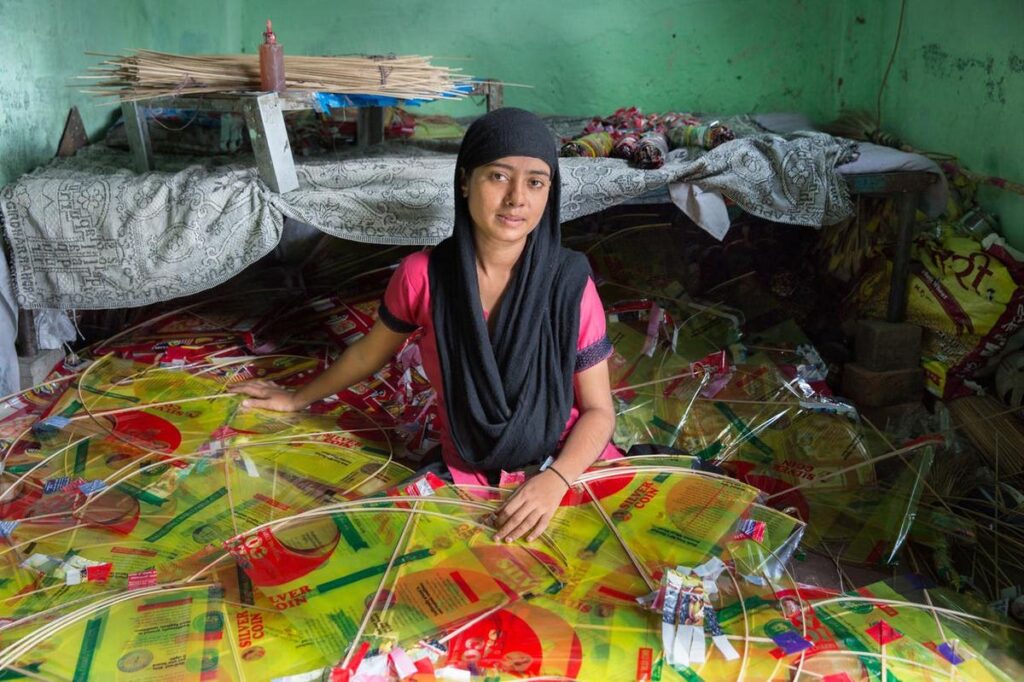Last year, India was battered by heat. Temperatures soared above 49°C (120.2°F) in some parts, setting records for March and April.
This kind of blistering heat is almost unliveable. “Our heads feel like they will explode,” Hema, a landfill worker outside Delhi, told The New Yorker.
Climate change made the heatwave about 30 times more likely. And climate change, wrought mainly by the greenhouse gas emissions of countries richer than India, will lead to similarly searing conditions in the future.
One novel way that some of India’s lowest-earning female workers are seeking to protect themselves is through heat-linked insurance. The Extreme Heat Income Insurance – a partnership of an organization of informal workers (the Self-Employed Women’s Association, or SEWA), an insurance technology firm (Blue Marble), and a nonprofit (the Adrienne Arsht-Rockefeller Foundation Resilience Center, or Arsht-Rock) – is a microinsurance product paid out when temperatures reach a specific threshold. SEWA is the group policyholder and ICICI Lombard is the local insurer.
The coverage period began on May 5 and will extend to June 30. The pilot covers 21,000 women in five districts of the state of Gujarat, where SEWA has a large membership base. Gujarat’s largest city, Ahmedabad, suffered a devastating heatwave in May 2010, when 1,344 excess deaths were recorded. Ahmedabad has since become a global leader in protecting those vulnerable to extreme heat.
Yet even in Gujarat, which has some of the world’s most extensive heat warning programs, there is scope for improvement. Sahil Hebbar, a consulting physician with SEWA, says that some members face challenges accessing and understanding heat advisories.
Workers who depend on daily wages also face difficult choices about working in searing heat. While agricultural laborers might be able to shift their working hours to begin around 4am and finish before the heat peaks, there is limited flexibility for construction workers, along with women who assemble products in their homes while tending to their families’ needs.
Those who want to carry on working as normal may not be able to. “As a result of the extreme heat conditions, their working hours suddenly shrink,” explains Reemaben Nanavaty, SEWA’s director. For instance, food vendors without cold storage might have to toss out spoiled products. SEWA members have reported losing 40 to 50% of their income on the hottest days.
The Extreme Heat Income Insurance is a way to compensate for some of that lost income, rather than to prevent people from working altogether on painfully hot days. There was limited time to ready the insurance for this heat season, so a simplified approach was taken to determining insurance payouts. In the pilot phase these are triggered after the fact, rather than being based on forecasts. It will likely take at least several days to actually receive the compensation. Given the time lag and the need to earn money daily, “our members will continue working regardless,” Hebbar believes.
But that compensation can be very useful as an income supplement during challenging periods. Heena Kamlesh Parmar, a construction worker in Ahmedabad, told Reuters that she would use a payout “to buy things for my house, things to eat.”
Similarly, Nanavaty says that extreme heat directly impacts the earnings of SEWA members, and “the three areas which are very badly affected are health, [children’s] education, and access to food.” Lower wages translate into less food, and members often can’t afford to take the time off work to seek healthcare when the heat makes them dizzy, feverish, or cramped. This means that “it further compounds. So a very minor heat related ailment could turn into something major.”
These major problems could include dermatological issues (for instance among ship breakers who work barefoot), urinary tract infections, and kidney stones (among women who become dehydrated because they lack drinking water or toilets in work sites). Nanavaty believes that the insurance benefits would help to keep workers nourished, hydrated, and better able to care for their health.
Focus groups convened by SEWA revealed that many members would be willing to contribute an insurance premium of 250–300 rupees (US$ 3.02–3.63), especially if they could make the payments across the heat season instead of in a lump sum. The average premium in the pilot is substantially higher than that, at approx. US$ 10 before taxes. But this is subsidized by Arsht-Rock and there can be up to six payouts, for a maximum of US$ 85. If the Extreme Heat Income Insurance had existed last year, payouts would have averaged US$ 28 per person, according to Blue Marble.
As this appears to be the first-ever heat-linked insurance product for informal-sector workers, SEWA had to communicate the benefits to members in accessible ways. The algorithm triggers a payout based on three days of satellite-assessed temperature data, within six 10-day cycles, customized to each of the five districts. For instance, in Ahmedabad, a minimum three-day temperature of 134°C (273°F), corresponding to an average of 44.7°C (112°F) would call for a payout. This may seem past the limits of endurance already, but it would be in line with the expectations of SEWA members, who said in the focus group discussions that outdoor work became challenging for them at 45°C (113°F).
Hebbar says that even for people with no prior experience of parametric insurance (insurance that does not depend on proven losses), “it’s easy enough to understand…that it’s not just a single day temperature trigger, it’s an average of three days. And I think that most [members] were on board with using an average.”
The team behind the new insurance product is hoping to expand the parameters in future iterations. While currently the payout threshold considers only daytime temperatures, a more complex measure in the future could also factor in temperatures at night, humidity, and health impacts. Ideally a future version would also be forecast-based rather than reactive.
The sustainability of this kind of insurance product may depend on the ability to raise further funds. Arsht-Rock has committed US$ 500,000 in addition to technical and communication support, and is seeking additional financing to scale up the insurance coverage. Parametric climate-linked insurance in low- and middle-income countries is a niche but growing field, primarily subsidized by nonprofits, governments, or donor countries.
“In our experience, for populations that have no experience with parametric insurance, beginning with subsidized products is the best approach to familiarize them with the product and build trust with the insurance as a concept,” explains Sarah Ebrahimi, Blue Marble’s head of institutional partnerships and head of personal insurance. “We use a design called Smart Subsidies, where the subsidy declines over time as the participants gain comfort with the product and can see the value it provides.”
Elsewhere in India, the Kerala Cooperative Milk Marketing Federation and the Agricultural Insurance Company recently launched a heat-linked insurance scheme for cow and buffalo farmers, as high temperatures reduce milk production. If temperatures exceed the threshold set for each area in Kerala (ranging from 33 to 37°C, or 91.4 to 98.6°F) for six days in a row, the dairy farmers receive compensation starting at 140 rupees (US$ 1.69).
SEWA emphasizes that its new insurance policy is one of multiple measures to adapt to rising temperatures. A complementary one is its climate fund, a pooled savings mechanism that helps members to save for items like home insulation materials. A particularly useful adaptation that home-based workers have been saving for is cool roofs, which Nanavaty says can reduce temperatures by several degrees.
Arsht-Rock and SEWA are also providing free shade tents and coolers. And SEWA is supporting members with affordable techniques like training them to prepare oral rehydration solution, an extremely effective way to counter dehydration, at home.
While the Extreme Heat Income Insurance has not yet triggered a payout, 2023 is already shaping up to be horribly hot. Heatwaves started hitting India in early March, and many are anxious about how extreme this heat season will be. “We all hope that it doesn’t go beyond 50°C [122°F], but the duration has definitely gotten extended,” says Nanavaty.
India’s informal workers are finding it increasingly challenging to cope with the heat. Hopefully, safety nets like the Extreme Heat Income Insurance will help buffer against some the worst effects of rising temperatures.
Read the full article here













